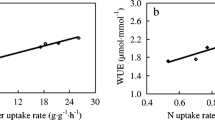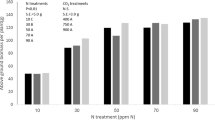Abstract
Hydroponic experiments were conducted in a greenhouse to examine the effects of different nitrogen (N) supply (low, 20 mg L−1; intermediate, 40 mg L−1; and high, 100 mg L−1) on the growth, nitrogen use efficiency, and photosynthetic characteristics of rice seedlings (Oryza sativa L., cv. “Shanyou 63” hybrid indica. China). Leaf gas exchange was conducted to identify the photosynthetic-limiting factors in plants with high N supply. The results showed that (1) shoot biomass, leaf area, and tiller numbers per plant under low N were lower than under intermediate and high N supplies. No significant differences were observed between plants supplied with intermediate and high N. (2) About a 35% increase in leaf N content in plants fed by high N resulted in about a 15% increase in carboxylation efficiency (CE) and photosynthetic rate. (3) The noncorresponding increases in photosynthetic rate in rice seedlings fed by high N relative to low N resulted from Rubisco activity and/or CE. (4) The decreased Rubisco activity was induced by a relatively insufficient CO2 supply under high N supply. These results indicated that insufficient CO2 supply under high N supply accounted for the decreased Rubisco activity and the noncorresponding increases in photosynthetic rate to leaf N content, and as a result, decreased (photosynthetic) nitrogen use efficiency.


Similar content being viewed by others
References
Bernacchi CJ, Portis AR, Nakano H, von Caemmerer S, Long SP (2002) Temperature response of mesophyll conductance. Implications for the determination of Rubisco enzyme kinetics and for limitations to photosynthesis in vivo. Plant Physiol 130:1992–1998
Bos HJ, Neuteboom JH (1998) Morphological analysis of leaf and tiller number dynamics of wheat (Triticum aestivum L.): responses to temperature and light intensity. Ann Bot 81:131–139
Cheng LL, Fuchigami LH (2000) Rubisco activation state decreases with increasing nitrogen content in apple leaves. J Exp Bot 51:1687–1694
Cruz JL, Mosquim PR, Pelacani CR, Araújo WL, DaMatta FM (2003) Photosynthesis impairment in cassava leaves in response to nitrogen deficiency. Plant Soil 257:417–423
Ding L, Wang KJ, Jiang GM, Biswas DK, Xu H, Li LF, Li YH (2005) Effects of nitrogen deficiency on photosynthetic traits of maize hybrids released in different years. Ann Bot 96:925–930
Evans JR (1989) Photosynthesis and nitrogen relationships in leaves of C3 plants. Oecologia 78:9–19
Evans JR, Terashima I (1987) Effects of nitrogen nutrition on electron transport components and photosynthesis in spinach. Aust J Plant Physiol 14:59–68
Farquhar GD, von Caemmerer S, Berry JA (1980) A biochemical model of photosynthetic CO2 assimilation in leaves of C3 species. Planta 149:78–90
Flexas J, Ribas-Carbó M, Hansom DT, Bota J, Otto B, Cifre J, McDowell N, Medrano H, Kaldenhoff R (2006) Tobacco aquaporin NtAQP1 is involved in mesophyll conductance to CO2 in vivo. Plant J 48:427–439
Good AG, Johnson SJ, Pauw MD, Carroll RT, Savidov N, Vidmar J, Lu ZJ, Taylor G, Stroeher V (2007) Engineering nitrogen use efficiency with alanine aminotransferase. Can J Bot 85:252–262
Guo SW, Zhou Y, Shen QR, Zhang FS (2007) Effect of ammonium and nitrate nutrition on some physiological processes in higher plants—growth, photosynthesis, photorespiration, and water relations. Plant Biol 9:21–29
Güsewell S (2005) High nitrogen:phosphorus ratios reduce nutrient retention and second-year growth of wetland sedges. New Phytol 166:537–550
Hasegawa H (2003) Crop ecology, management & quality. Crop Sci 43:921–926
Jensen RG (2000) Activation of Rubisco regulates photosynthesis at high temperature and CO2. Proc Natl Acad Sci USA 97:12937–12938
Jin SH, Hong J, Li XQ, Jiang DA (2006) Antisense inhibition of Rubisco activase increases Rubisco content and alters the proportion of Rubisco actibase in stroma and thylakoids in chloroplasts of rice leaves. Ann Bot 97:739–744
Khamis S, Lamaze T, Lemoine Y, Foyer C (1990) Adaptation of the photosynthetic apparatus in maize leaves as a result of nitrogen limitation. Relationships between electron transport and carbon assimilation. Plant Physiol 94:1436–1443
Leegood RC, Sharkey TD, von Caemmerer S (2004) Photosynthesis: physiology and metabolism. Kluwer Academic Publishers, New York, pp 1–55
Li CS, Salas W, DeAngelo B, Rose S (2006) Assessing alternatives for mitigating net greenhouse gas emissions and increasing yields from rice production in China over the next twenty years. J Environ Qual 35:1554–1565
Li Y, Gao YX, Xu XM, Shen QR, Guo SW (2009) Light-saturated photosynthetic rate in high-nitrogen rice (Oryza sativa L.) leaves is related to chloroplastic CO2 concentration. J Exp Bot 60:2351–2360
Linka M, Weber APM (2005) Shuffling ammonia between mitochondria and plastids during photorespiration. Trends Plant Sci 10:461–465
Mae T (1997) Physiological nitrogen efficiency in rice: nitrogen utilization, photosynthesis, and yield potential. Plant Soil 196:201–210
Makino A, Mae T, Chira K (1985) Photosynthesis and ribulose-1,5-bisphosphate carboxylase/oxygenase in rice leaves from emergence through senescence. Planta 166:414–420
Makino A, Mae T, Chira K (1986) Colorimetric measurement of protein stained with Coomassie Brilliant Blue Ron sodium dodecyl sulfate-polyacrylamide gel electrophoresis by eluting with formamide. Agric Biol Chem 50:1911–1912
Makino A, Shimada T, Takumi S, Kaneko K, Matsuoka M, Shimamoto K, Nakano H, Miyao-Tokutomi M, Mae T, Yamamoto N (1997) Does decrease in ribulose-1,5-bisphosphate carboxylase by antisense RbcS lead to a higher N-use efficiency of photosynthesis under conditions of saturating CO2 and light in rice plants? Plant Physiol 114:483–491
Mancus P (2007) Nitrogen fertilizer dependency and its contradictions: a theoretical exploration of social-ecological metabolism. Rural Sociol 72:269–288
Manter DK, Kerrigan J (2004) A/Ci curve analysis across a range of woody plant species: influence of regression analysis parameters and mesophyll conductance. J Exp Bot 55:2581–2588
Odum EP (1989) Input management of production systems. Science 243:177–182
Ookawa T, Naruoka Y, Sayama A, Hirasawa T (2004) Cytokinin effects on ribulose-1,5-bisphosphate carboxylase/oxygenase and nitrogen partitioning in rice during ripening. Crop Sci 44:2107–2115
Poorter H, Evans JR (1998) Photosynthetic nitrogen-use efficiency of species that differ inherently in specific leaf area. Oecologia 116:26–37
Sage RF, Pearcy RW (1987) The nitrogen use efficiency of C3 and C4 plants. Plant Physiol 84:959–963
Sage RF, Pearcy RW, Seemann JR (1987) The nitrogen use efficiency of C3 and C4 plants. Plant Physiol 85:355–359
Samonte SO, Wilson LT, Medley JC, Pinson SR, McClung AM, Lales JS (2006) Nitrogen utilization efficiency: relationships with grain yield, grain protein, and yield-related traits in rice. Agron J 98:168–176
Spreitzer RJ, Salvucci ME (2002) Rubisco: structure, regulatory interactions, and possibilities for a better enzyme. Ann Rev Plant Biol 53:449–479
Walker TW, Martin SW, Gerard PD (2006) Grain yield and milling quality response of two rice cultivars to top-dress nitrogen application timings. Agron J 98:1495–1500
Warren CR (2004) The photosynthetic limitation posed by internal conductance to CO2 movement is increased by nutrient supply. J Exp Bot 55:2313–2321
Wingler A, Lea PJ, Quick WP, Leegood RC (2000) Photorespiration: metabolic pathways and their role in stress protection. Philos Trans R Soc Lond B Biol Sci 355:1517–1529
Youngdahl LJ, Pacheco R, Street JJ, Vlek PLG (1982) The kinetics of ammonium and nitrate uptake by young rice plants. Plant Soil 69:225–232
Yu K, Patrick WH Jr (2003) Redox range with minimum nitrous oxide and methane production in a rice soil under different pH. Soil Sci Soc Am J 67:1952–1958
Zhong XH, Peng SB, Sanico AL, Liu HX (2003) Quantifying the interactive effect of leaf nitrogen and leaf area on tillering of rice. J Plant Nutr 26:1203–1222
Acknowledgments
This work was supported by the National Natural Science Foundation of China (30671233, 30871587), the Program for New Century Excellent Talent in Universities (NCET-07-0438), and the Program for Excellent Ph.D. Candidates in Jiangsu Province (CX09B_240Z). We thank the late Prof. Dr. Burkhard Sattelmacher, and Dr. Holger Brueck and Prof. Dr. Ulf-Peter Hansen, Institute of Plant Nutrition and Soil Science, Kiel University, Germany, for their suggestions in this study.
Author information
Authors and Affiliations
Corresponding author
Rights and permissions
About this article
Cite this article
Li, Y., Yang, X., Ren, B. et al. Why Nitrogen Use Efficiency Decreases Under High Nitrogen Supply in Rice (Oryza sativa L.) Seedlings. J Plant Growth Regul 31, 47–52 (2012). https://doi.org/10.1007/s00344-011-9218-8
Received:
Accepted:
Published:
Issue Date:
DOI: https://doi.org/10.1007/s00344-011-9218-8




